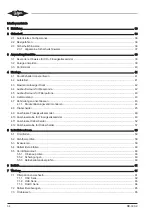
DB-300-9
28
!
!
NOTICE
Risk of damage to the motor and compressor!
Do not start the compressor while it is in a va-
cuum!
Do not apply any voltage, not even for testing!
5.4
Charging refrigerant
Use only permitted refrigerants, see chapter Application
ranges, page 6.
DANGER
Risk of bursting of components and pipelines
due to hydraulic excess pressure while feeding
liquid.
Serious injuries are possible.
Avoid overcharging the system with refrigerant
under all circumstances!
WARNING
Risk of bursting due to counterfeit refrigerants!
Serious injuries are possible!
Purchase refrigerants only from reputable man-
ufacturers and reliable distributors!
!
!
NOTICE
Risk of wet operation during liquid feeding!
Measure out extremely precise quantities!
Keep the oil temperature above 40°C.
◦ Before charging with refrigerant: Do not switch the
compressor on!
◦ Switch on oil heater at the compressor and oil separ-
ator.
◦ Check the oil level in the compressor.
• Charge the condenser or receiver directly with liquid
refrigerant; on systems with flooded evaporator,
maybe also the evaporator.
• Blends must be taken out of the charging cylinder as
a solid liquid.
• After commissioning, it may be necessary to add re-
frigerant: While the compressor is running, charge
with refrigerant on the suction side, preferably at the
evaporator inlet.
5.5
Compressor start
5.5.1
Checking the oil level
In the oil separators, the oil level must be visible in the
sight glass or, at the most, 5 cm below it.
5.5.2
Vibrations
The whole system, particularly the pipelines and capil-
lary tubes, must be checked for abnormal vibrations. If
required, take additional safety measures.
!
!
NOTICE
Risk of burst pipes and leakages on the com-
pressor and system components!
Avoid strong vibrations!
DANGER
Risk of bursting the pressure device due to
mechanical stress.
Serious injuries are possible.
Connect the pipeline to the pressure unit without
stress!
5.5.3
Checking the operating data
• Evaporation temperature
• Suction gas temperature
• Condensing temperature
• Discharge gas temperature
• Oil temperature
• Cycling rate
Prepare data protocol.
Summary of Contents for F062H(P)
Page 3: ...DB 300 9 3 8 Decommissioning 33 ...
Page 35: ...DB 300 9 35 8 Außer Betrieb nehmen 65 ...
Page 67: ...DB 300 9 67 8 Mettre hors service 98 ...
Page 99: ...Notes ...















































